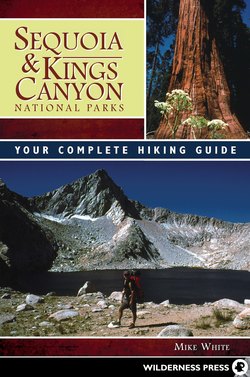Читать книгу Sequoia and Kings Canyon National Parks - Mike White - Страница 24
На сайте Литреса книга снята с продажи.
ОглавлениеMINERAL KING TRAILHEAD
TRIP 8
Mosquito Lakes
DH or BPx
DISTANCE: 6.5 miles, out-and-back
ELEVATION: 7,815′/9,585′, +2,135′/-375′/±5,020′
SEASON: Early July to mid-October
USE: Moderate
MAPS: USGS’s Mineral King or SNHA’s Mineral King
TRAIL LOG
1.0 White Chief Canyon Trail junction
1.75 Eagle Lake Trail junction
3.25 Mosquito Lake #1
INTRODUCTION: The six enchanting Mosquito Lakes range from densely forest-rimmed to barren and rockbound. Formerly, the lakes were extremely popular destinations before the 1.5-mile trail from Cold Springs Campground was abandoned, camping at the Lake #1 was prohibited, and the trail beyond the first lake devolved into a cross-country route. Nowadays, a smattering of dayhikers trek up the newer trail to the first lake, but only a few of those travel farther off-trail to the upper lakes, offering a good chance of solitude for those who do make the journey.
At each of the lakes, the scenery is sublime, the swimming is refreshing, and the fishing for brook trout is reportedly good. Lake #3 has the best campsites for backpackers. Traces of the old trail still exist and cairns mark the way, which allows for straightforward route-finding. Be forewarned that these lakes received their name for a reason—be prepared for hordes of mosquitoes in early summer.
DIRECTIONS TO TRAILHEAD: From the east end of Three Rivers, leave Highway 198 and turn onto Mineral King Road. Follow the road past Atwell Mill Campground, Silver City, Cold Springs Campground, and Mineral King Ranger Station (which issues wilderness permits and has food storage areas) to the Eagle-Mosquito Trailhead parking area at the end of the road, 23.5 miles from Highway 198.
DESCRIPTION: Just south of the parking area, a dirt road heads past the Honeymoon Cabin and climbs gently up the East Fork Kaweah River Canyon through sagebrush scrub dotted with red firs, mountain maples, and a few western junipers. After a quarter mile, you cross Spring Creek on a removable wood bridge. Within earshot of the bridge but out of sight above the trail is Tufa Falls. The creek originates higher up the hillside and then follows a subterranean course through a band of marble before emerging a few hundred feet above the trail.
Just beyond Spring Creek, pass an unsigned lateral descending toward the river and proceed up the canyon, with good views of Crystal Creek cascading down the slope across the valley. Hop across willow-lined Eagle Creek and shortly arrive at the signed White Chief Canyon junction, 1 mile from the parking area.
Lake #3 from Mosquito Lakes Trail
Turn right at the junction and wrap around the hillside to a set of steep switchbacks that climb through pockets of meadow alternating with stands of red fir and lodgepole pine. The grade eases on the approach to Eagle Sinkhole, where Eagle Creek mysteriously disappears. Resume climbing, soon passing the Eagle Lake junction, 1.75 miles from the parking area.
From the junction, the trail ascends through red firs to the crest of Miners Ridge, from where a 0.75-mile switchbacking descent leads to Mosquito Lake #1, 3.25 miles from the trailhead. The oval-shaped lake is backed by a talus slope and encircled by lodgepole pines. Camping is banned here in an attempt to restore the native vegetation.
UNMAINTAINED TRAIL
Old signs near the outlet of Mosquito Lake #1 mark a junction with the unmaintained trail descending Mosquito Creek to a junction with the Tar Gap Trail, a half mile from Cold Springs Campground. This old trail was a shorter, but much steeper, route to the lakes.
A now unmaintained trail used to climb to the upper lakes, part of which is still evident as far up the canyon as Lake #3. From the outlet of Lake #1, follow distinct tread around the west shore and then head south up a steep hillside, where blazes and cairns will help guide you. To the east of Lake #2, another steep but short climb leads to Lake #3, where a pair of small islands and an amphitheater of towering white rock cliffs combine for some pretty scenery. Slabs on the south shore will entice sunbathers and swimmers, while anglers can ply the waters for brook trout. A sparse forest of lodgepole pines encircling the lake shade fine campsites.
Above Lake #3, signs of the old trail finally disappear for good. Cairns may be of assistance as you head cross-country up the next hillside to the right of a rocky slope. The route passes well to the east of Lake #4 and then proceeds toward irregularly shaped Lake #5, whose grassy shoreline is dotted with scattered lodgepoles, tucked against the cliffs of Miners Ridge.
The route to austere, treeless Mosquito Lake #6, the last lake in the chain, continues another quarter mile up the canyon.
Off-trail enthusiasts can follow a short but challenging loop back to the trailhead by making an extremely steep ascent from the vicinity of Mosquito Lake #4 over Miners Ridge and down to Eagle Lake. From there, reverse the description in Trip 9.
Mineral Lakes can be accessed via a straightforward route over a saddle directly west of Mosquito Lake #4.
Wilderness permits are required for overnight stays. Campfires are prohibited. Camping is banned at Mosquito Lake #1.
